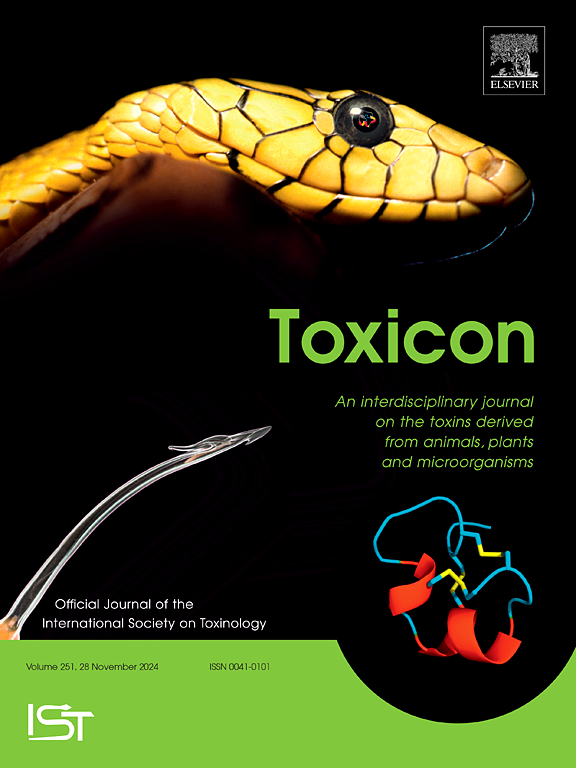利用高效液相色谱-PDA 法检测和定量印度东北部野生蘑菇中的天门冬酰胺毒素,以保障食品安全。
IF 2.6
4区 医学
Q2 PHARMACOLOGY & PHARMACY
引用次数: 0
摘要
误食毒蘑菇对食品安全构成重大威胁,尤其是在印度米佐拉姆邦,在过去十年(2013-2023 年)中已报告了十余起因蘑菇中毒导致的死亡事故。本研究旨在通过确定和量化食用印度米佐拉姆邦 Champhai 地区野生蘑菇导致死亡的原因,并测试 HPLC-PDA 检测和量化金曲霉毒素的可靠性,从而解决这一关键问题。α-amanitin是一种水溶性、热稳定的高毒性环状八肽,存在于天南星属(包括Amanita phalloides、Amanita verna和Amanita virosa)中。鹅膏蕈素的细胞毒性来自于对 RNA 聚合酶(即 RNA 聚合酶 II)的抑制,从而阻碍肾脏和肝脏细胞中 mRNA 的产生。该方法具有良好的精密度和准确度,最低检出限(LOD)为88 ng g-1,最低定量限(LOQ)为210 ng g-1。该方法被成功地用于定量检测十种野生蘑菇样品中的α-amanitin,结果显示只有紫蘑菇(1.17 mg g-1)和双孢蘑菇(1.91 mg g-1)中含有α-amanitin。这些发现强调了准确的 α-amanitin 检测方法在确保食品安全和公共卫生方面的重要性,尤其是在易发生蘑菇中毒事件的地区。值得注意的是,这项研究标志着在米佐拉姆邦 Champhai 地区野生毒蘑菇中检测和定量α-amanitin 的初步探索,这也是该地区首次报告此类情况。本文章由计算机程序翻译,如有差异,请以英文原文为准。

Detection and quantification of Amatoxin in wild mushrooms from North-East India using HPLC-PDA method for food safety purposes
Misidentification and ingestion of poisonous mushrooms pose significant threats to food safety, particularly in Mizoram, India, where over ten fatalities due to mushroom poisoning have been reported in the past decade (2013–2023). This study aimed to address this critical issue by identifying and quantifying the cause of death due to consumption of wild mushroom from Champhai district, Mizoram, India and to test the reliability of HPLC-PDA for detection and quantification of amatoxins. HPLC-PDA confirmed the presence of α-amanitin in Amanita virosa and Amanita bisporigera in the samples. α-amanitin is a water-soluble, heat-stable, and highly toxic cyclic octapeptide present in the genus Amanita, which includes Amanita phalloides, Amanita verna, and Amanita virosa. Amanitin cytotoxicity arises from the inhibition of RNA polymerases, namely RNA polymerase II, which obstructs mRNA production in kidney and liver cells. Validation of the method demonstrated good precision and accuracy, with LOD and LOQ values of 88 ng g−1 and 210 ng g−1, respectively. The method was successfully applied to quantify α-amanitin in ten wild mushroom samples, revealing its presence only in Amanita virosa (1.17 mg g−1) and Amanita bisporigera (1.91 mg g−1) species. These findings underscore the importance of accurate α-amanitin detection methods in ensuring food safety and public health, particularly in regions prone to mushroom poisoning incidents. It is noteworthy that this study marks the initial exploration for detection and quantification of α-amanitin from poisonous mushrooms found in the wild regions of Champhai district in Mizoram, representing the first report of such in the area.
求助全文
通过发布文献求助,成功后即可免费获取论文全文。
去求助
来源期刊

Toxicon
医学-毒理学
CiteScore
4.80
自引率
10.70%
发文量
358
审稿时长
68 days
期刊介绍:
Toxicon has an open access mirror Toxicon: X, sharing the same aims and scope, editorial team, submission system and rigorous peer review. An introductory offer Toxicon: X - full waiver of the Open Access fee.
Toxicon''s "aims and scope" are to publish:
-articles containing the results of original research on problems related to toxins derived from animals, plants and microorganisms
-papers on novel findings related to the chemical, pharmacological, toxicological, and immunological properties of natural toxins
-molecular biological studies of toxins and other genes from poisonous and venomous organisms that advance understanding of the role or function of toxins
-clinical observations on poisoning and envenoming where a new therapeutic principle has been proposed or a decidedly superior clinical result has been obtained.
-material on the use of toxins as tools in studying biological processes and material on subjects related to venom and antivenom problems.
-articles on the translational application of toxins, for example as drugs and insecticides
-epidemiological studies on envenoming or poisoning, so long as they highlight a previously unrecognised medical problem or provide insight into the prevention or medical treatment of envenoming or poisoning. Retrospective surveys of hospital records, especially those lacking species identification, will not be considered for publication. Properly designed prospective community-based surveys are strongly encouraged.
-articles describing well-known activities of venoms, such as antibacterial, anticancer, and analgesic activities of arachnid venoms, without any attempt to define the mechanism of action or purify the active component, will not be considered for publication in Toxicon.
-review articles on problems related to toxinology.
To encourage the exchange of ideas, sections of the journal may be devoted to Short Communications, Letters to the Editor and activities of the affiliated societies.
 求助内容:
求助内容: 应助结果提醒方式:
应助结果提醒方式:


